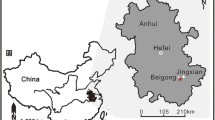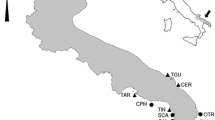Abstract
The demosponge siliceous spicules, entrapped in the Mediterranean coralligenous bioherms, are a good tool for reconstructing the sponge ancient communities across time, also allowing a comparison with the current biodiversity. The aim of this paper has been the description of the ancient sponge assemblages of the coralligenous bioherms grown up in the Tavolara-Capo Coda Cavallo Marine Protected Area (northeastern Sardinia, Tyrrhenian Sea) between 5800 and 3700 YBP and its comparison with the living sponge community. On the base of radiocarbon age determinations, it was possible to estimate that these bioherms cover a span of time ranging from the Holocene Climatic Optimum until the Bronze Age Crisis. Their growth rates, 0.21–0.24 mm year−1, were of the same order of estimations conducted around the Mediterranean. The Tavolara ancient sponge diversity was compared with those found in ancient accretions from Ligurian Sea and Ionian Sea. Our results supported the already-described general trend, supporting the hypothesis that the genus richness in the coralligenous bioherms was driven by climatic vicissitudes. Nevertheless, our data strongly indicated that the sponge diversity is also related to the conditions of the coralligenous structures: in the accretions characterized by an active growth of coralline algae the number of sponge genera is similar to those recorded in the ancient assemblages while in coralligenous where the accretion is stopped the number of sponge genera strongly decreases probably due to the competition with frondose macroalgae.







Similar content being viewed by others
References
Ballesteros E (2006) Mediterranean coralligenous assemblages: a synthesis of present knowledge. Oceanogr Mar Biol Ann Rev 44:123–195
Belmonte G, Ingrosso G, Poto M, Quarta G, D’Elia M, Onorato R, Calcagnile L (2009) Biogenic stalactites in submarine caves at the Cape of Otranto (SE Italy): dating and hypothesis on their formation. Mar Ecol 30(3):376–382
Bertolino M, Cerrano C, Bavestrello G, Carella M, Pansini M, Calcinai B (2013) Diversity of Porifera in the Mediterranean coralligenous accretions, with description of a new species. ZooKeys 336:1–37
Bertolino M, Calcinai B, Cattaneo-Vietti R, Cerrano C, Lafratta A, Pansini M, Pica D, Bavestrello G (2014) Stability of the sponge assemblage of the Mediterranean coralligenous along a millennial span of time. Mar Ecol 35:149–158
Bertolino M, Costa G, Carella M, Cattaneo-Vietti R, Cerrano C, Pansini M, Quarta G, Calcagnile L, Bavestrello G (2017a) The dynamics of a Mediterranean coralligenous sponge assemblage at decennial and millennial temporal scales. PLoS ONE 12(5):e0177945
Bertolino M, Cattaneo-Vietti R, Costa G, Pansini M, Fraschetti S, Bavestrello G (2017b) Have climate changes driven the diversity of a Mediterranean coralligenous sponge assemblage on a millennial timescale? Palaeogeogr Palaeoclimatol Palaeoecol 487:355–363
Bracchi VA, Basso D, Marchese F, Corselli C, Savini A (2017) Coralligenous morphotypes on sub horizontal substrate: a new categorization. Contin Shelf Res 144:10–20
Calcagnile L, Quarta G, D’Elia M (2005) High resolution accelerator-based mass spectrometry: precision, accuracy and background. Appl Radiat Isot 62:623–626
Calcinai B, Moratti V, Martinelli M, Bavestrello G, Taviani M (2013) Uncommon sponges associated with deep coral bank and maerl habitats in the Strait of Sicily (Mediterranean Sea). Ital J Zool 80(3):412–423. https://doi.org/10.1080/11250003.2013.786763
Cerrano C, Bavestrello G, Bianchi CN, Calcinai B, Cattaneo-Vietti R, Morri C, Sarà M (2001) The role of sponge bioerosion in the Mediterranean coralligenous accretion. In: Faranda FM, Guglielmo L, Spezie G (eds) Mediterranean ecosystems: structure and processes. Springer Verlag, Italy, pp 235–240
Dagli E, Çinar ME, Ergen Z (2011) Spionidae (Annelida: Polychaeta) from the Aegean Sea (eastern Mediterranean). Ital J Zool 78:49–64
Di Geronimo I, Di Geronimo R, Rosso A, Sanfilippo R (2002) Structural and taphonomic analysis of a columnar coralline algal build-up from SE Sicily. Geobios 35:86–95
Donghia G, Capezzuto F, Cardone F, Carlucci R, Carluccio A, Chimienti G, Corriero G, Longo C, Maiorano P, Mastrototaro F, Panetta P (2015) Macro-and megafauna recorded in the submarine Bari Canyon (southern Adriatic, Mediterranean Sea) using different tools. Mediterran Mar Sci 16(1):180–196
Garrabou J, Ballesteros E (2000) Growth of Mesophyllum alternans and Lithophyllum frondosum (Corallinales, Rhodophyta) in the northwestern Mediterranean. Eur J Phycol 35(1):1–10
Giaccone G (2007) Il coralligeno come paesaggio marino sommerso: distribuzione sulle coste italiane. Biologia Marina Mediterranea 14(2):126–143
Guido A, Heindel K, Birgel D, Rosso A, Mastandrea A, Sanfilippo R, Russo S, Peckmann J (2013) Pendant bioconstructions cemented by microbial carbonate in submerged marine caves (Holocene, SE Sicily). Palaeogeogr Palaeoclimatol Palaeoecol 388:166–180
Hong J-S (1980) Etude faunistique d’un fond de concrétionnement de type coralligène soumis à un gradient de pollution en Méditerranée nord-occidentale (Golfe de Fos). Thèse Dr Univ Aix-Marseille 2:1–268
Ingrosso G, Abbiati M, Badalamenti F, Bavestrello G, Belmonte G, Cannas R, Benedetti-Cecchi L, Bertolino M, Bevilacqua S, Nike Bianchi C, Bo M, Boscari E, Cardone F, Cattaneo-Vietti R, Cau A, Cerrano C, Chemello R, Chimienti G, Congiu L, Corriero G, Costantini F, De Leo F, Donnarumma L, Falace A, Fraschetti S, Giangrande A, Gravina MF, Guarnieri G, Mastrototaro F, Milazzo M, Morri C, Musco L, Pezzolesi L, Piraino S, Prada F, Ponti M, Rindi F, Russo GF, Sandulli R, Villamor A, Zane L, Boero F (2018) Mediterranean bioconstructions along the Italian Coast. Adv Mar Biol 79:61–136. https://doi.org/10.1016/bs.amb.2018.05.001
Kiirikki M (1996) Experimental evidence that Fucus vesiculosus (Phaeophyta) controls filamentous algae by means of the whiplash effect. Eur J Phycol 31(1):61–66
Laborel J (1961) Le concrétionnement algal “coralligène” et son importance géomorphologique en Méditerranée. Recl des Trav Stn Mar d’Endoume 23:37–60
Laborel J (1987) Marine biogenic constructions in the Mediterranean: a review. Sci Rep Port-Cros Natl Park 13:97–126
Laubier L (1966) Le coralligène des Albères: monographie biocénotique. Annales de l’Institut Océanographique Monaco 43:139–316
Longo C, Mastrototaro F, Corriero G (2005) Sponge fauna associated with a Mediterranean deep-sea coral bank. J Mar Biol Assoc UK 85(6):1341–1352
Longo C, Cardone F, Pierri C, Mercurio M, Mucciolo S, Marzano CN, Corriero G (2017) Sponges associated with coralligenous formations along the Apulian coasts. Mar Biodiv. https://doi.org/10.1007/s12526-017-0744-x
Mastrototaro F, D’onghia G, Corriero G, Matarrese A, Maiorano P, Panetta P, Gherardi M, Longo C, Rosso A, Sciuto F, Sanfilippo R, Gravili C, Boero F, Taviani M, Tursi A (2010) Biodiversity of the white coral bank off Cape Santa Maria di Leuca (Mediterranean Sea): an update. Deep Sea Res Part II Topical Stud Oceanogr 57(5–6):412–430
Pergent-Martini C, Alami S, Bonacorsi M, Clabaut P, Daniel B, Ruitton S, Pergent G (2015) New data concerning the coralligenous atolls of Cap Corse: an attempt to shed light on their origin. In: 2nd Mediterranean Symposium on the conservation of Coralligenous and other Calcareous Bio-Concretions. Portorož, Slovenia, 29–30 October 2014
Pirazzoli PA (2005) A review of possible eustatic, isostatic and tectonic contributions in eight late-Holocene relative sea-level histories from the Mediterranean area. Quat Sci Rev 24(18):1989–2001
Riding R (2000) Microbial carbonates: the geological record of calcified bacterial-algal mats and biofilms. Sedimentology 47:179–214
Ros J, Romero J, Ballesteros E, Gili J (1985) The circalittoral hard bottom communities: the coralligenous. In: Margalef R (ed) Western Mediterranean. Pergamon Press, Oxford, pp 263–273
Santos GG, Pinheiro U, Hajdu E, Van Soest R (2016) New genus and species of Heteroxyidae from Brazil (Axinellida: Demospongiae: Porifera), with a revised identification key for the family. Zootaxa 4158(1):105–116
Sartoretto S, Francour P (1997) Quantification of bioerosion by Sphaerechinus granularis on ‘coralligène’ concretions of the Western Mediterranean. J Mar Biol Assoc UK 77(2):565–568
Sartoretto S, Verlaque M, Laborel J (1996) Age of settlement and accumulation rate of submarine “coralligène” (− 10 to − 60 m) of the north-western Mediterranean Sea; relation to Holocene rise in sea level. Mar Geol 130:317–331. https://doi.org/10.1016/0025-3227(95)00175-1
Schiaparelli S, Franci G, Albertelli G, Cattaneo-Vietti R (2005) A non-destructive method to evaluate population structure and bioerosion activity of the boring bivalve Gastrochaena dubia. J Coast Res 21(9):383–386
Sitjà C, Maldonado M (2014) New and rare sponges from the deep shelf of the Alboran Island (Alboran Sea, Western Mediterranean). Zootaxa 3760(2):141–179
Sivan D, Wdowinski S, Lambeck K, Galili E, Raban A (2001) Holocene sea-level changes along the Mediterranean coast of Israel, based on archaeological observations and numerical model. Palaeogeogr Palaeoclimatol Palaeoecol 167(1):101–117
Teixidó N, Garrabou J, Harmelin JG (2011) Low dynamics, high longevity and persistence of sessile structural species dwelling on Mediterranean coralligenous outcrops. PLoS ONE. https://doi.org/10.1371/journal.pone.0023744
Acknowledgements
This study was financially supported by a SIR grant (Italian Ministry for the Education #RBSI14CH49) and by RITMARE project (Italian Ministry for the Environment). We wish to thank the personnel of the Tavolara MPA for their kind support.
Author information
Authors and Affiliations
Corresponding author
Rights and permissions
About this article
Cite this article
Bertolino, M., Costa, G., Cattaneo-Vietti, R. et al. Ancient and recent sponge assemblages from the Tyrrhenian coralligenous over millennia (Mediterranean Sea). Facies 65, 30 (2019). https://doi.org/10.1007/s10347-019-0573-4
Received:
Accepted:
Published:
DOI: https://doi.org/10.1007/s10347-019-0573-4




